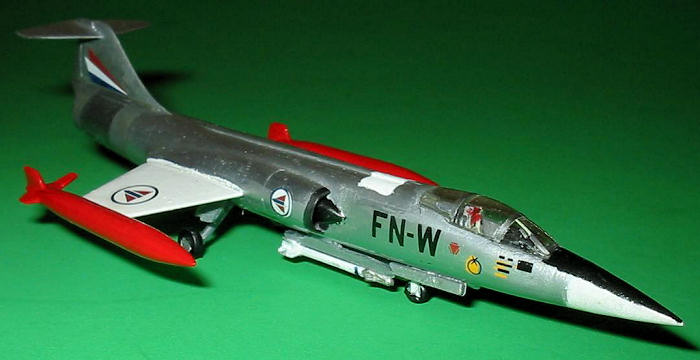
Minicraft 1/144 F-104G Starfighter
| KIT #: | ? |
| PRICE: | $9.95 SRP |
| DECALS: | One option |
| REVIEWER: | Bill Abbott |
| NOTES: | The price has gone up in the last year or so |

| HISTORY |
In the origin myth of the F-104, Korean war fighter pilots complained that
fighters had become too complex. (Can they have been describing the F-86? The
F2H Banshee?) Pilots said they wanted simple fighters with bubble gum stuck on
the windscreen for a gunsight... (How can you bore-sight a single piece of gum
stuck to the the windscreen?) Maybe the combination of gyro gunsight and radar
ranging in the F-86 was unreliable and irritating. The MiG-15 DID have an
altitude advantage over all other fighters in Korea.
The myth continues that Clarence "Kelly" Johnson listened to these complaints
and produced the F-104 as an uncompromised high-performance solution that
nothing could out-run or get above. It was WAY fast and WAY pointy. Fairings
were put over the YF-104A's production J-79 engine intakes at first, because the
automatic, variable area, double shock intakes with moving "mice" were secret.
The wings were essentially solid and really did require padded protectors over
the leading edges, to prevent ground crew injury. Compressor "bleed" air was
ducted to the flaps, entraining low-speed airflow and reducing take off and
landing speeds to merely spectacular.
Lockheed called the F-104 a "StarFighter" but it was also called "The missile
with a man in it", for obvious reasons.
Lockheed got to build 153 "A" and 77 "C" model daylight interceptors, and 47 "B"
and "D" two seat trainers, but the story would have ended there without a
remarkable transform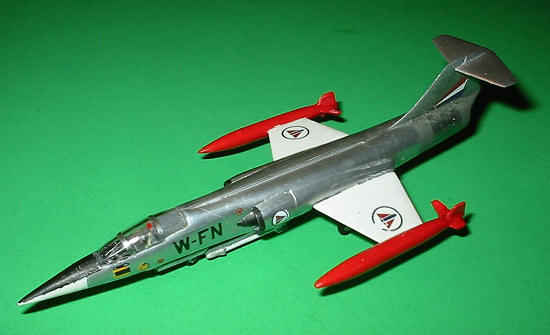 ation-
Lockheed's daylight hotrod interceptor was restressed and redesigned to be an
all-weather nuclear strike fighter. Same tiny wing, same big engine, more radar
modes, lots more hard-points to hang air-to-ground weapons on...
ation-
Lockheed's daylight hotrod interceptor was restressed and redesigned to be an
all-weather nuclear strike fighter. Same tiny wing, same big engine, more radar
modes, lots more hard-points to hang air-to-ground weapons on...
Astonishingly, when the F-104G won NATO's competition for nuclear strike
fighters, 9 NATO members (Belgium, Denmark, Germany, Greece, Italy, the
Netherlands, Norway, Spain and Turkey) actually bought them. Lockheed in the USA
and 6 licensed prime contractors in 5 NATO nations (Canada, Italy, the
Netherlands, West Germany and Belgium) built F-104Gs. Lockheed's biggest single
model production run was 172 TF-104G, all for European operators. Total F-104
production was therefore:
Lockheed: 741 including prototypes
Multi-national:48 - all TF-104Gs
Canadair:340
Aeritalia/Fiat:444
Fokker:350
MBB:50
Messerschmitt:210
Mitsubishi:207
SABCA:188
Grand total, 2578
As the last hurrah, Lockheed and Aeritalia/Fiat developed the F-104S all weather
interceptor, uniquely armed with semi-active radar homing Sparrow/Skyflash
missiles. The 245 "S" models used a larger and higher power J-79 engine, common
to F-4 Phantom IIs.
| THE KIT |
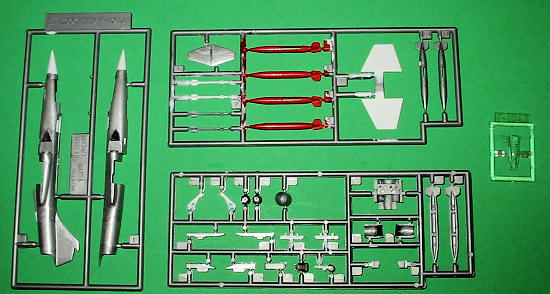 The
F-104C daylight interceptor was also built in Japan as the F-104J, which is why
someone (Crown?) made this very nice 1/144 kit many years ago.
The
F-104C daylight interceptor was also built in Japan as the F-104J, which is why
someone (Crown?) made this very nice 1/144 kit many years ago.
The kit has a conventional parts breakdown and comes as two trees of silver
plastic snd one tree of clear. The left and right fuselage halves are full
length and the wing is one piece. Fine, light, raised lines indicate panels and
control surfaces. A one-piece ejection seat, somewhat like the original,
Lockheed, downward ejection seat, is the sole cockpit part. Four external fuel
tanks are included, two for the wing tips and two for underwing pylons. Four
Sidewinder missiles are also supplied, and two under-fuselage pylons for a pair
of them- the other pair are alternatives to the tip tanks on the wings, or
possibly the wing pylons. No second set of Sidewinder launch rail/adaptors is
included, however.
Minicraft's current release of this kit is as-if a G, with Norweigan markings. A
real "G" might have had a centerline pylon and additional wing stations but this
J has the same broad chord rudder as the G. At the level of detail provided, the
two are indistinguishable.
| CONSTRUCTION |
The seat can be installed any time before the canopy, so construction begins
with the fuselage. I should have followed the instruction sheet and put in
the engine exhaust before joining the fuselage halves. After the fuselage is
joined, the exhaust won't fit in place without modifications, and/or
cracking the aft fuselage joint.
 of
the bottle but the metalics in particular are too thick to really look good.
So I thin a brushfull with a few drops of water and then lay it down very
gently. If I get it right, it needs a second coat to cover, but no more,
of
the bottle but the metalics in particular are too thick to really look good.
So I thin a brushfull with a few drops of water and then lay it down very
gently. If I get it right, it needs a second coat to cover, but no more,
I painted the cockpit interior and ejection seat an overall Dark Gull Gray,
with a black instrument panel, black for the lower seat structure and a red
head-rest on the seat. The seat pad/parachute/emergency kit is grayish
green. Four skinny strips of tan masking tape mad
The kit's engine air intakes need a little help if you want them to blend
undetectably. I accepted slightly detectable- they blended well enough with
Testors' blue label, non-toxic, liquid cement. After the glue dried, I used
wet-dry sanding sticks to smooth the fuselage and intake seams. Then I
painted everything except the wing and drop tanks with rattle can Metalizer
(Buffing) Aluminum Plate. A day to dry, a polish with a facial tissue and
light coat of Future to seal it took care of all the plain aluminum
surfaces.
All F-104s in natural metal had their wings painted white, so several coats
of Polly Scale white went over the wing part, with two coats of Future floor
wax for gloss. A few light passes with a sanding stick exposed bare plastic
at the joints so I could glue the wing and fuselage together. A center
underside piece encloses the wing joint. There were gaps too big for cement
to solve, so after it dried, I filled them with Elmer's White Glue. When
*that* dried, I dry-brushed Polly Scale's now discontinued Bright Silver
acrylic to match the polished Metalizer aluminum.
I was trying to keep Advanced Modeler Syndrome (AMS) at bay and get this
present from my son done, so I added only three pieces: A tombstone shaped
piece of 0.04" (1mm) styrene, curved end forward, raised the top of the
cockpit glare shield. Two 0.02" (0.5mm) sheet extensions to the inboard fins
on the wing-tip tanks made them look much more like the real thing- a couple
of mm, long, 3/32", maybe a bit more, and slightly tapered. Any picture or
plan of the F-104's tip tanks will show these fins. The four fins on the
tip-tanks are all different and the completed tanks are handed, left and
right. The un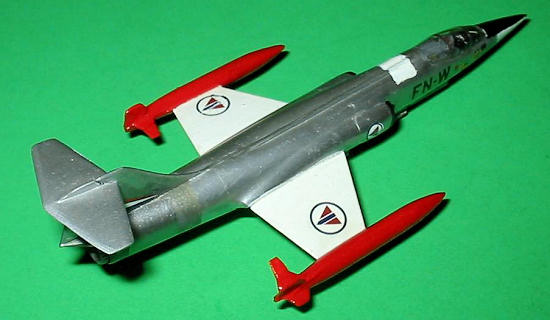 derwing
auxillary tanks were a third design. The supply folks must have just loved
it!
derwing
auxillary tanks were a third design. The supply folks must have just loved
it!
The only major trimming needed was narrowing the upper half of the ejection
seat-back and head-rest. The canopy needed a little flash removed. Other
than that, mold parting lines were light and easily removed.
Landing gear legs and doors install easily. The instructions are ambigious
about where the notched edge of the main gear door goes. I concluded that
the cutout should go aft, but I now suspect that may be wrong. I also got
the nose gear doors exchanged, left and right- the tapered ends go foreward,
and the outline of the well should taper up forward as well.
I glued the horizontal stabilizer in place before spraying Metalizer, then
knocked it off while trying to mask and paint the titanium skin on the
rudder (see below) I didn't re-attach the stabilizer until the rest of the
rudder painting and decals were done, and I'd advise leaving it until last,
along with the drop tanks, missiles, etc. It was convenient to use the
rudder, slipped between the top and bottom of a kit box, or between two
books, to hold the kit upside down or vertically, while the glue dried for
landing gear, gear doors, etc.
The tip tanks were the last pieces to attach, after painting both the wing
and the tanks. They probably should go on before the national marking decals
on the wings, another lesson learned. Some long, thin, strips of masking
tape from the tanks to the center of the fuselage held the tanks in the
right position while the glue dried. I only damaged one decal taking the
tape off... The 'horizontal' tail fins on the tip tanks should line up with
the wing anhedral.
| COLORS & MARKINGS |
Unless otherwise noted, all paints used were Polly Scale acrylics, brushed
in several coats.
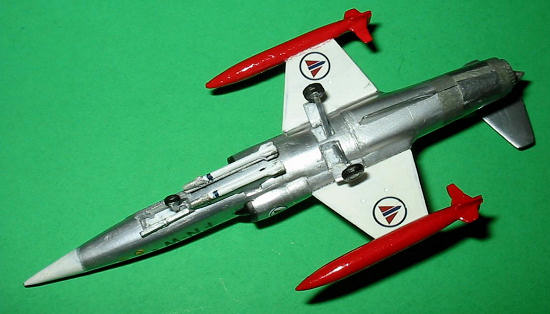 The
intake lips and moving 'mice" should be finished as a black anti-icing
treatment. A white radome and antenna panel behind the cockpit, and a black
anti-glare panel ahead of the windshield, are correct and look very elegant.
As long as the white paint is out, the gear wells and the inside of the gear
doors should be white, but legs and hubs are aluminum paint. I painted the
tires black and the engine exhaust Tamiya XF-56 Metalic Gray, thinned gently
with water. I find the Tamiya acrylic paints brush well out e seat and
shoulder belts for the ejection seat.
The
intake lips and moving 'mice" should be finished as a black anti-icing
treatment. A white radome and antenna panel behind the cockpit, and a black
anti-glare panel ahead of the windshield, are correct and look very elegant.
As long as the white paint is out, the gear wells and the inside of the gear
doors should be white, but legs and hubs are aluminum paint. I painted the
tires black and the engine exhaust Tamiya XF-56 Metalic Gray, thinned gently
with water. I find the Tamiya acrylic paints brush well out e seat and
shoulder belts for the ejection seat.
As far as I can tell, the forward fuselage metal skin of an F-104 was all
aluminum except for antennae covers and canopy, But the aft fuselage over
the afterburner and the rudder were something else. I concluded that there
was a titanium skin on the most aft part of the fuselage, and in a band
below the leading edge of the rudder. The skin in between these two titanium
sections looks like stainless steel. The rudder skin *between* the titanium
bands on the fuselage appears to be titanium as well,
So I painted the titanium bands and pannels of the rudder skin with Tamiya
Metalic Gray. Working with the raised lines on the model and a long, firm,
square brush, I free-hand painted the front edge of the front titanium band,
filled in the front band and repeated for the aft band. The rudder titanium
skin was masked with 3M long release (blue) masking tape and brush painted
at the same time. It took 2 coats, just like it should. Then I sprayed a
piece of old Guillows' decal- (thick, easy to apply, and strong), with
Metalizer Stainless Steel. When dry, I polished it and then sealed it with
Future. It took a bit of work to cut a shape that would drape over the
curved and tapered tube of the F-104 aft fuselage. It was too wide when
applied (off the thick decal paper), but a brand new X-acto blade cut the
too-wide ends off, neatly, where they overlapped the base of the fin. The
crisp edge of the decal made a nice boundary between the titanium and the
stainless steel. The resulting three-tone natural metal finish looked really
nice, to me.
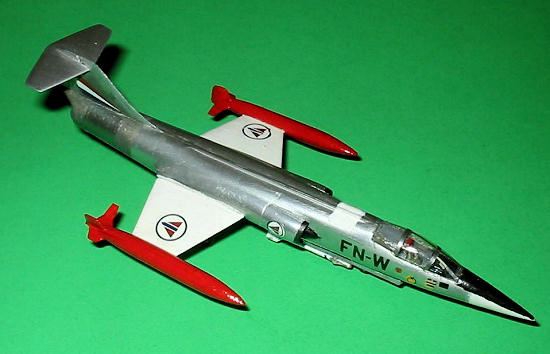 The
tip tanks got a white undercoat before I brushed Testors Acryl II gloss red
in several, light, coats. The Sidewinders are white overall, with Metalic
Gray for the guidance section and a ring marking just aft of the guidance
section.
The
tip tanks got a white undercoat before I brushed Testors Acryl II gloss red
in several, light, coats. The Sidewinders are white overall, with Metalic
Gray for the guidance section and a ring marking just aft of the guidance
section.
I gave the canopy the usual brush-coat of Future floor wax (AKA Kleer). Four
narrow strips of left-over "stainless steel" decal made crisp and simple
canopy frames- two longer bits, hoops, one of which had to basicly be glued
on with Future, and two short bits for the frame supporting the flat, center
panel of the windscreen.
Using water and Micro-Set, the kit decals went on easily and dried tight and
smooth. Registration wasn't that great between the blue and red on the
Norweiagan national markings. As long as I had to repair the damage I did
with the tape that held the drop-tanks, I touched-up the registration
problem of the national markings too.
The various small markings on the forward fuselage were combined into two
decals, one for each side, that went on easily, fit correctly and look
great. Ejection seat and canopy warnings and emergency operation, fueling
point and other items are sufficiently complete for this scale.
| CONCLUSIONS |
It looks great, all done, on the shelf, after 2 months real time. Overall
shape seems right compared to the plans in the Verlinden "Lock-on F-104 J/G"
book. The hinge arms on the nose gear doors are nice.
Reflecting the kit's age, the AIM 9 Sidewinder missile fins are probably too
narrow, and the forward fuselage missile rails are too deep. Stick and
cockpit consoles, various antennae, the radome Pitot tube, landing gear door
actuators/struts and the landing and navigation lights are not included but
could be invented readily enough.
| REFERENCES |
Lock-On No.1 - F-104 G/J Starfighter - Hans Wilms (C) 1983, Verlinden
Publications Belgium ISBN 90-70932-01-6
Fighters of the Fifties - Bill Gunston (C) 1981 Specialty Press, Osceola, WI,
ISBN 0-933424-32-9
The World's Military Aircraft - Bill Gunston (C) 1983 Octopus/Crescent
London/New York ISBN 0-517-40477X
Modern Military Aircraft - Bill Gunston (C) 1977 Salamander/Crescent London/New
York ISBN 0-517-22477-1
Thanks to my son Benjamin and my wife Jean's wallet for this tidy little kit!
If you would like your product reviewed fairly and quickly, please contact the editor or see other details in the Note to Contributors.